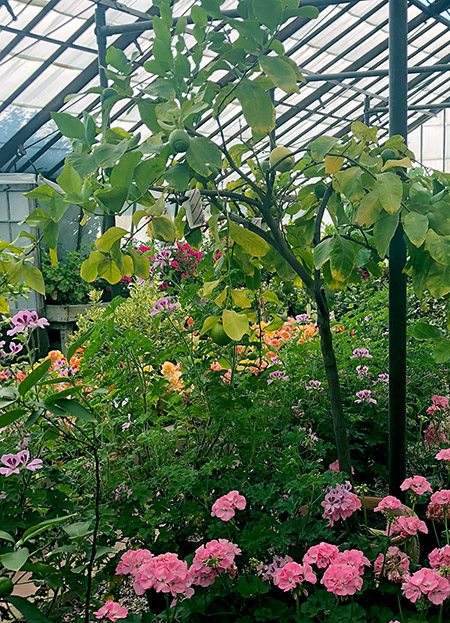
Walking across the east lawns with the dogs, I duck under a fence to take a short cut through to the Orangery, glasshouses and cold frames. The dogs follow their own paths there but are not allowed into the Orangery, both on account of the plants and the fact that Highclere’s Head Gardener and his team store their backpacks there, complete with carefully wrapped sandwiches, none of which seems to defeat the nose and determination of a Labrador to share what isn’t theirs.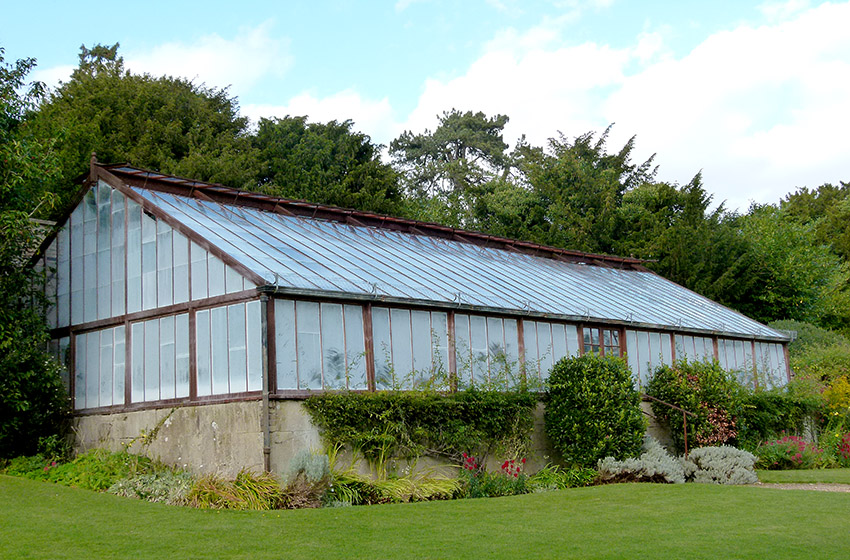
The Orangery used to be part of the original Georgian House and was attached to the south side of the building to what was the Breakfast Room. It is clearly marked out in a drawing made by Sir Charles Barry when he was building the current Castle, before he moved it ½ mile down to sit beside the Monks’ Garden, with its long glass wall facing south.
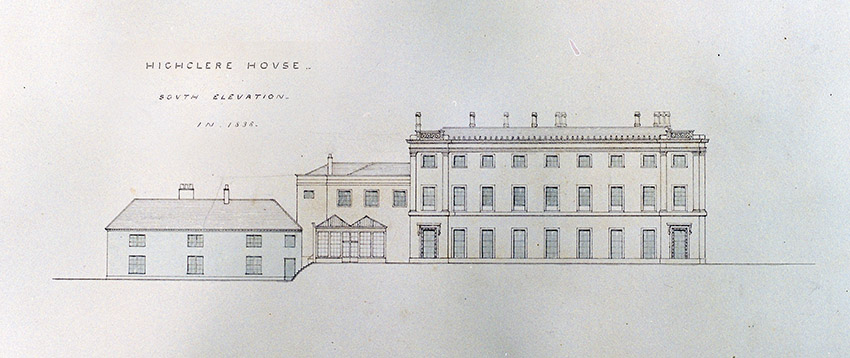
This rather lovely and practical building was not wasted. It was put to good use as the fruits produced within its glass walls were much admired and valued at a time when this was the only way to enjoy such tender produce from Mediterranean climes.
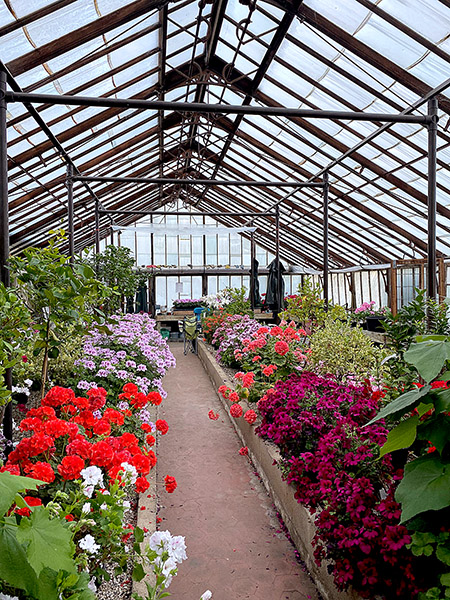 It had become somewhat dilapidated. We have now repaired it and we are looking at ways to share its produce so that it does not remain just a cost centre. The glass walls allow lemon trees and kumquats – tiny orange trees – to flourish. When I first came here, I used the lemons to make syllabub and lemonade. The expression “making lemonade from lemons” denotes turning something sour or pedestrian into sometime delicious or useful: not everyone may see this opportunity but life is good if you can find a way to be positive about what it has dealt you. Lemons, however bitter, taste wonderful if you are creative with them. Likewise, if we take the time and look, it is amazing what we can see and achieve.
It had become somewhat dilapidated. We have now repaired it and we are looking at ways to share its produce so that it does not remain just a cost centre. The glass walls allow lemon trees and kumquats – tiny orange trees – to flourish. When I first came here, I used the lemons to make syllabub and lemonade. The expression “making lemonade from lemons” denotes turning something sour or pedestrian into sometime delicious or useful: not everyone may see this opportunity but life is good if you can find a way to be positive about what it has dealt you. Lemons, however bitter, taste wonderful if you are creative with them. Likewise, if we take the time and look, it is amazing what we can see and achieve.
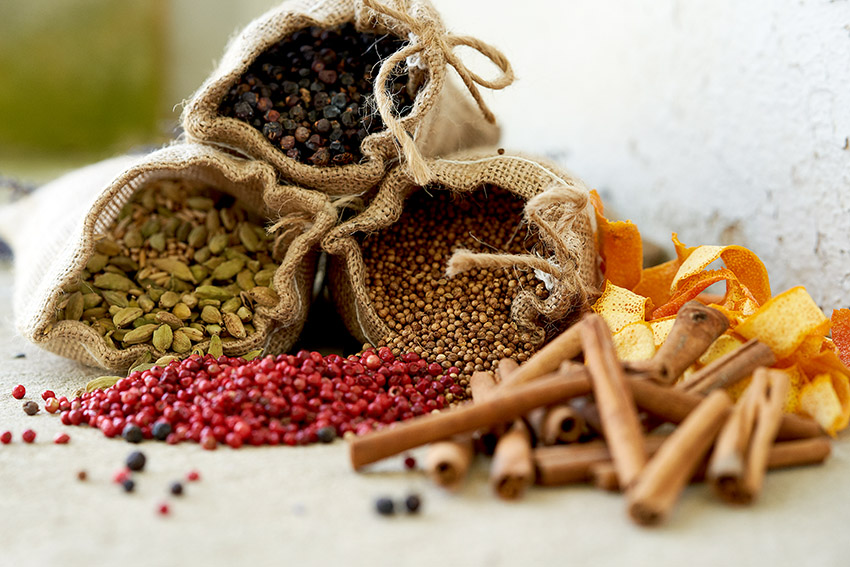
Gin botanicals
When we were considering making our own Gin, Geordie was particularly keen to put the Orangery at the centre of its story. Thus, Highclere Castle Gin uses the citrus notes from here to refresh and to balance the gin taste. The lemons are air dried and sent to the distillery which now takes priority over my lemon possets and lemonade! Nothing is easy or obvious but the effort to step forwards may be more ingenious as a result.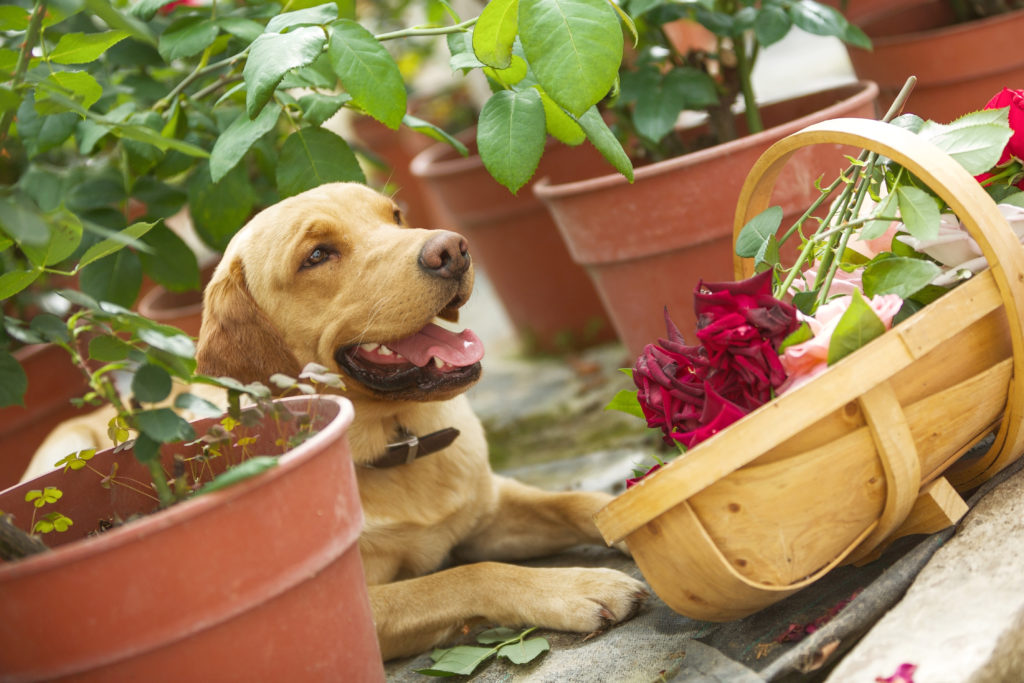
Equally you cannot use lemons to make something they are not – you can use them for balance and as a flavour but they are still lemons. Many fables and legends are stories, often quite scary ones, about someone pretending to be someone they are not, and usually for nefarious purposes. The last few months have tested many of our assumptions about our daily lifestyles. With humankind less in evidence, in some places nature has cleansed itself from seas and lagoons to city centres. It would be nice when this is over if we could retain some of this achievement.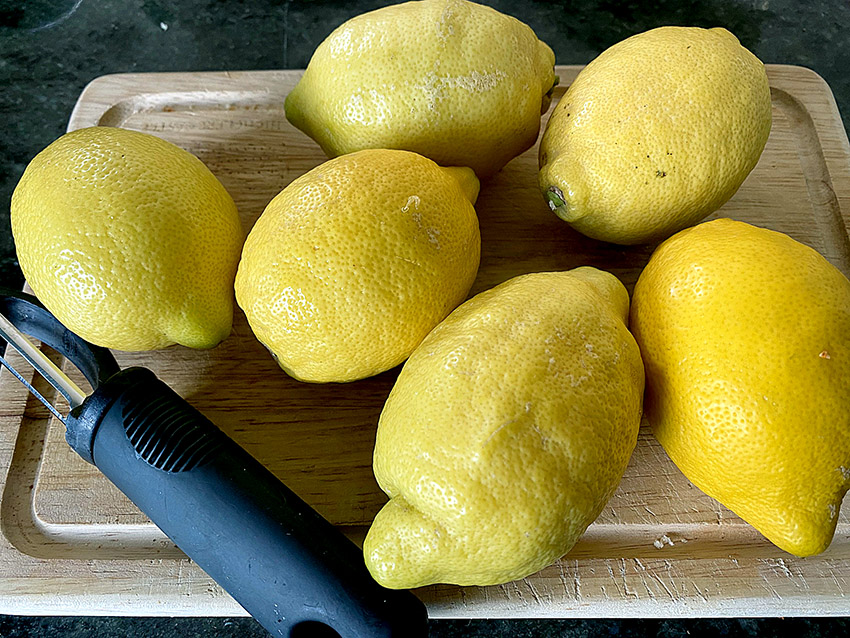
The Lemonade recipe below is a balance between the tart refreshing taste of the lemons and the sweetness of sugar, perhaps flavoured with a little mint as well. The required balance of the two is up to individual taste so that there is no one correct answer. What is more, it needs continual adjustment depending on the juiciness of the lemons.
The Stoics believe that, within humans, there is a “divine spark” which helps them to live in accordance with nature. My father loved to delve into conversation with my university friends to encourage them to try, to have a go at an industry or a job, and remind them they had spark. He was a lover of William Shakespeare – “We know what we are, but know not what we may be.”
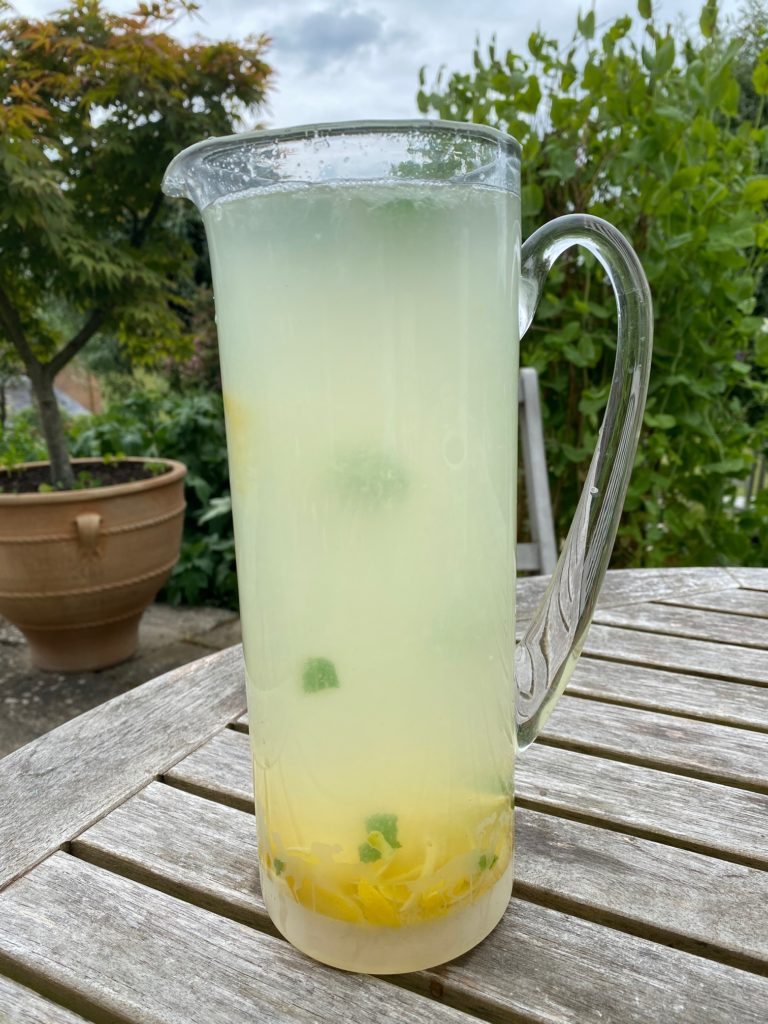
Step 1 infusing..
Making lemonade
Ingredients: 6 lemons, 150 g of sugar, a few torn mint leaves, 2 1/2 pints of water
Scrub the lemons in warm water, pare the yellow zest from 3 of them using a potato peeler or zester (avoid the white pith which is bitter), Pare a 4th lemon and keep the strips to one side. Squeeze the juice from all the lemons into a bowl, with the sugar and add 2½ pints of boiling water and the torn mint leaves. Stir well, cover and leave overnight in a cool place. 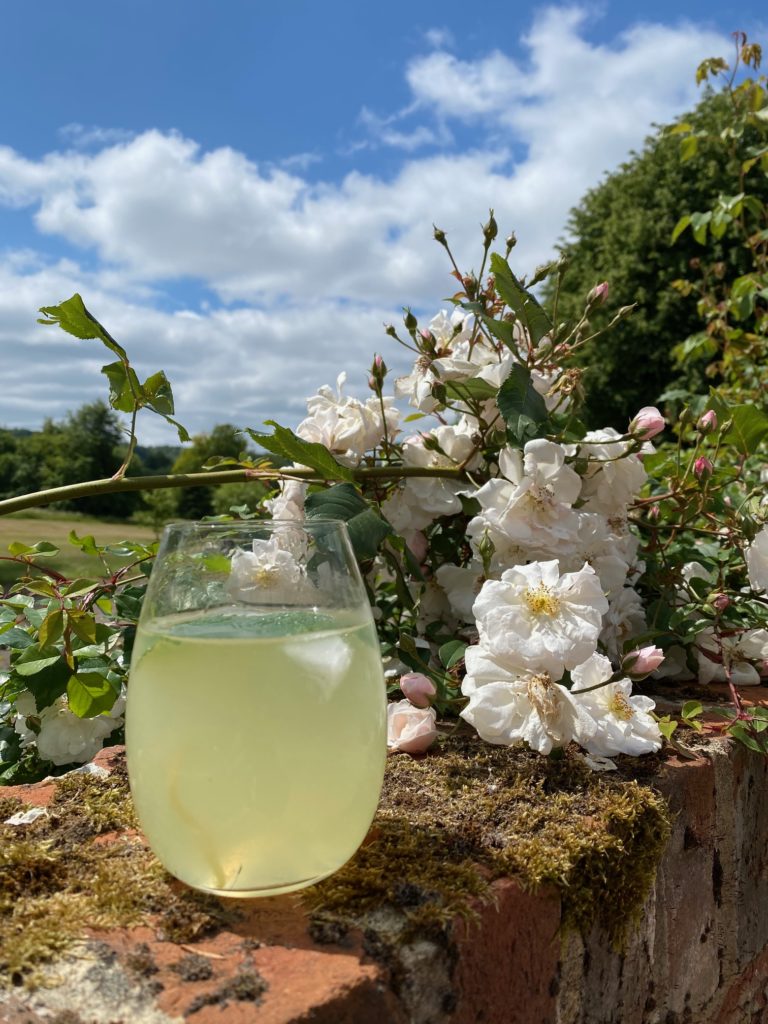 Next day stir again, taste to check and add a little more sugar if needed. finally sieve the lemonade through a large sieve and serve with ice cubes and some more mint leaves and the strips of zest from the 4th lemon for colour.
Next day stir again, taste to check and add a little more sugar if needed. finally sieve the lemonade through a large sieve and serve with ice cubes and some more mint leaves and the strips of zest from the 4th lemon for colour.








 Instagram
Instagram
I always look forward to your newsletters, and this week, especially so. It is apparent we live in a very dark time. A story about plants, dogs, gin, kumquats, and lemons, provides a glimmer of light, if only for a moment. Thank you.
Thank you, sounds lovely I will try this.
Nothing like Homemade Lemonade on a hot Summers day
It has gone down well with our sparse office team today
Lovely blog and receipt. Lemonade made by scratch with the addition of mint from the garden is wonderful on a hot summers day. Certainly hot now in Atlanta, GA as summer is here! Thank you for writing these blogs and opening your home to the public. I very much enjoyed my visit October 2019 and hope to do so again in the future.
Lady Carnarvon, The top photo of this weeks blog is stunning. The lemonade recipe sounds wonderful. I will make a jug for sure. I too hope that when things return to normal it will be a better world to live in. Unknown quote, In a world where you can be anything, be kind. Kind Regards, Cheryl
Agreed!
As I look out my studio window in our home in southwest Florida, I view a very large Myer’s lemon tree that gives us a bountiful crop of lemons each year. We are busy during harvest juicing the lemons to place in jars to freeze to savor the juice for lemonade that amazes our friends when they dine with us with a meal primarily made from the vegetables and fruits from our mini-farm. We have two Myers lemon bushes plus an addition of two regular lemon trees. You’ll almost always find something to add to the refrigerator crisper drawer with whatever is in season: mulberries, kumquats, loquats, peaches, key limes, oranges of various varieties, figs, avocados, plus all the garden items: radishes, onions, okra, cucumbers, green beans, herbs, and more. Whatever comes to the kitchen is what’s for lunch! In our tropical climate, we can have a garden year round. We share our harvest bounties with friends and neighbors and in turn, they keep an eye on our place when we travel in our motor home. So, you see dear Lady, the fruits of your labor gives life lemons…lemons that will give you smiles, conversation, and love of your land. I do enjoy your postings, especially when you share a recipe. Thank you!
How has COIVD 19 effected your daily running of the palace and how have you overcome these challenges ??
Regards
Rista
South Africa
Like for other businesses it has been a near catastrophe – we have worked long gruelling hours and are deeply appreciative of the support of visitors who have transferred. We are picking ourselves up to go forwards but it will be a long “swim” out for the next few years..
Good Morning Lady Carnarvon. Wouldn’t it have been great to be able to watch Sir Charles Barry move this magnificent building? Beautiful sitting of nature inside and outside the building. Thank you for sharing your lovely home. Have a great day.
Yes I would love to have done so too!
:))
Nice for the eyes and mind
I’m just smiling now and because I do have many organic lemons in my fridge , I’m going to go now make lemonade ))
Thank you for sharing those beautiful pictures I feel privileged
R
Wonderful and my jug is more or less empty.. perhaps another batch later this week
Dear Lady Carnarvon,
Once again your blog was a great start to my week.
I, too, love how one can turn this sour fruit into something wonderful and sweet, much like life. This morning I made a delicious Lemon Lavender Pound Cake.
Thank you for sharing those beautiful photos and your lemonade recipe.
All the best,
Theresa Franz
Im going to try this. Thank you for sharing your recipe.
Thank you for reminding us to enjoy what we have. I must say I would love to bea Highclere enjoying its beauty, views & your lemonade.
Thank you! I live in Orlando, Florida and have always wanted to plant a Lemon Tree! You have inspired me to do so! If you can grow lemons in England, I can certainly do it if Florida!
Sounds a wonderful project
Hi Jim,
I also live in Orlando. Yes, of course, you can grown lemons here. Oranges, grapefruit, lemons and limes. Plant a couple varieties for good pollination and you will by making lemonade next summer!
Good luck & Cheers,
Peggy Helbling
Windermere, Florida
I shall use your recipe this week, thankyou. I have 4 lemon trees in my conservatory, but to keep them healthy and ventilated, I have to move them outside for the Summer. This is no easy task. Do yours stay I side all year round?
They do!
Thank you for sharing. I do have a lemon tree here in northern California and I will put you recipe to good use
Lady Carnarvan –
I really enjoy reading your blog and looking forward to making your Lemonade recipe!
We hope to visit in the near future when things are back to normal.
Dear Lady Carnarvon,
Thank you so much for sharing the delightful receipe for lemonade. I shall have to try it. I do prefer lemonade over sweet tea in the summer even though I currently reside in South Carolina where sweet tea is popular. I enjoyed the photos and history of the orangeory. I so look forward to reading your posts each Monday as they are very inspiring and are prompting me to visit Highclere in the future. Again thank you so very much.
Thank you so much
Dear Lady Carnarvon,
Several years ago, on one of my first visits to Highclere, I remember heading to the Gardens and peeking into the Orangery, thinking what a splendid building it is. Refurbishing the building will yield more flowers, fruit and other wonders for all to enjoy. Lemons to lemonade applies on so many levels. We are living through incredibly disturbing times and in the midst of it all, if we can find ways to continue with positive thoughts and actions, we will come through it in a far better place.
On a lighter note, I love the photo of the botanicals used in the Highclere Gin. I absolutely love your gin and it’s beautiful unique flavor. Just received my second bottle!
Thank you for the lemonade recipe – presently on the “to do” list!
May you and your family continue to stay well and healthy.
Best regards,
Charlotte Merriam Cole
You could just add gin to the lemonade too!!!!
I;m super sick but blog makes me fell better
I am so sorry – lemonade!
Dear Lady Carnarvon,
Hello from Arkansas! What an interesting and beautiful post. I have always thought it would be wonderful to have a greenhouse in my backyard. The one at Highclere is huge. The plants inside are lovely. Thank you for sharing the lemonade recipe. I look forward to making it for my family. Would you tell me what is syllabub?
When this difficult time is over, I truly believe there will be more positives than negatives in the “new normal”. For me, just being able to be with family and friends enjoying a great meal and game night will be treasured.
All the best to you today!
How nice to restore and reuse this glasshouse. I love your remark on everyone having a “divine spark”, I quite agree! Since we have so much idle time these days, it’s something for everyone to ponder perhaps while sitting in their own garden… Thanks for the lemonade recipe, I’ll be giving that a try with a splash of gin!
J
yes – great idea!
Thanks for the recipe. It is very timely & sounds refreshing! I didn’t know about the Orangery & don’t think I saw it when we were there two years ago. Glad it’s been restored and put to good use.
I always look forward to Mondays and your blog.
Thank you.
Oh how wonderful that the glass house was repaired! Do I see the year 1838 written on Sir Charles Barry South Elevation drawing? I certainly enjoy learning something new about your home each week. Thanks for including your dogs once in awhile too.
Amazing drawings …
Buenos días,
In Puerto Rico we grow lemons which are so much better than the imported ones. People tend to confuse lemons and limes, both being different in color and in taste. Because we are in the tropics, our lemonade is always made with cold water. I’m going to give a try to your recipe with the boiling water and refrigerate until the next date. I will let you know if it makes a difference…love the idea of adding some mint!
A tip – if you can source fresh cane sugar it adds a special sweet touch…
Stay safe and keep writing! It adds a little magic to our confinement..albeit our beautiful sun, sky and sea!
Matilde
Do try i and let me know what you think, and the few torn mint leaves are also worth trying – I just left the jug overnight last night
I have just discovered your Monday blog posts as my daughter and I – latecomers to ‘Downton’ – now enjoy our forays into Highclere during lockdown (and thank heavens for it, being one of the only programmes we agree on!).
Your blog – isn’t that an awful word?! – is so enjoyable! Inviting, it is, at once, both informative and vibrant. Ironically, not a great one for reading blogs, I, myself, have written one for several years now – Trish-Trash.com. My nickname at school, it affords me the opportunity to write about anything and everything. – and I do! I think you might like it …
I do agree – not sure about the word blog at all
Hello Lady Carnarvon
I love your Orangery but please check your lemon tree in there? The yellowing of the leaves means it is lacking in something. Here I would give my trees a big dose of epsom salts followed by a deep watering and I do the same for my gardenias too.
I love lemons and use them every day. I start my morning with some lemon juice in warm water and that really sets me up for the day. I make Lemon Butter (some call it Lemon Curd), use lemon peel to make Candied Lemon Peel and always make my own Preserved Lemons which are lovely in Moroccan foods. The list goes on. I have never made my own Lemonade though and your blog this week has me making a note to make it this coming summer.
Putting lemons in your Gin Recipe is an inventive idea and completely different to anything I have heard of before. I recall an old Aunt of mine took her Gin in Orange Juice but that was maybe to hide from my uncle just how much Gin she had in her glass 🙂
Winter is upon us in Australia and I find it very hard to get out of bed in the morning especially when it has snowed about 50 miles from where I live. The snow is only light and is gone usually by lunch time but it can get very cold overnight…………minus 4 last night and a maximum of 9 degrees Celsius today…….brrrrrr.
Here in Australia we have just about overcome the Corona Virus and we are gradually being allowed to socialise but still with distancing and hand washing etc. Hopefully it will not come back now people are out and about.
Stay safe well and happy
Joy Roebig
I will try that ref the lemon tree – thank you
Lady Carnarvon,
Your post this morning reminds me of how new parents try to help their children find their way, as infants and as they grow, conquer new realms of experience. Just as we are understanding a somewhat new world, with different, sometimes exciting, sometimes disappointing times, we really do want new ways of living and behaving, perhaps with a “divine spark,” to inspire us. Enjoying life with post-pandemic lemonade should help.
Thanks for another inspiring post.
Martha G.
Thank you
As always, lovely writings with a useful message. I so look forward to your musings on Monday mornings.
Good morning from Fort Worth, Texas! I am the proud owner of a Meyer lemon tree, given to me by my daughter-in-law a couple of years ago. It wasn’t thriving under her care and she asked me if I wanted it. Of course, I said yes. When I got the tree, it was a pitiful sight; bare branches with no apparent chance of surviving. I repotted it, loved on it, talked to it, and ignored people who laughed at me. Three weeks passed. No leaves. So I talked to it again, pronouncing “Do better than this, or you go in the trash.” Within a week, leaves sprouted. We have so enjoyed the lemons from this determined little tree. A lesson to be learned: loving care (threats), patience, and tending to the needs of the unlovely will bear fruit to be enjoyed.
We have a lemon tree at our vacation home in Tucson, Arizona which bears prolifically every other year. We usually make limoncello out of the excess, but now we’ll make your wonderful lemonade, too … with an ounce – OK, two ounces – of Highclere Castle Gin! Another great Monday blog.
Thank you ! I might make another jug for our Virtual Cocktail Party this Friday..
I would love to have the Lemon Lavender Pound Cake from Theresa Franz!
Always enjoy your Monday postings … thanks for sharing.
Dear Lady Carnarvon,
May I make a respectful suggestion? Would you consider adding a link to the Highclere shop/products, or to the Highclere website, on your blog’s home page? It would make it a bit easier to shop so as to support Highclere’s business.
Best wishes.
How kind – what a lovely idea!
I look forward every week to your Monday Musings!!! What an inspiring way to start the new week. Thank you for sharing ♥️
Going to make a jar of your lemonade today!!
Thank you for your posts…. they are appreciated! Takes us on a “little vacation” for a bit. 🙂
I love your blogs! My husband and I visited your estate last summer. We traveled to England to see his brother (who was in the last stages of lung cancer) and sisters. My only request to my husband during this somber visit was to visit your lovely home. What a bright spot in our 3 week visit. The weather could not have been more beautiful and welcoming. We did stop by and see the greenhouse and Monks garden area. We both love gardening and took such pleasure with all of the lovely area. Thank you for providing such a treasure to be seen by the masses.
Toni
I hope you will come back again. Memories are precious and we need to keep building them
I always enjoy your information and especially like the recipe. Please send any other recipes you can share
Thank you
Just best regards and love to you Lady Carnarvon. You brighten my Mondays! Karen from NJ
I thoroughly enjoyed visiting your lovely home and surrounding grounds three years ago. Thank you for sharing it with all of us.
I also enjoy reading your blog. Today I found out what Syllabub and Posset are. They sound like a wonderful treat and I will make…ok, attempt to make them this weekend.
Best wishes from Texas, USA for a speedy recovery for you and yours.
They are delicious and for summer..
I must be missing it, but I don’t see in the Lemonade recipe what is to be done with the zest from the first 3 lemons. Does it go into the mix when the torn mint leaves are added?
I love all things lemon. Highclere Castle Limoncello might make a lovely addition to your “drinks” line.
My fault – yes into the jug is the juice of 6 lemons, the sugar and the zest. pout over the water break up and some mint leaves and stir every so often as it cools. I left it overnight and strained it the this morning. It is not too tart and not too sweet – see what you think!
I was looking for this answer. Thank you!
Wonderful reminder to add citrus beverages to my mix. Sweet tea is a Texas staple too, but I need the variety of lemonade and limeade. Noting to add to the grocery list as my most recent limes died before use. Sniff, sniff. Thank you for sharing with us every Monday. We all need such friends to lighten our lives these days.
Thw lemonade went down so well I am on course to make some more tomorow!
Look forward to always reading new posts to your blog. Thank you for the lemonade and other recipes, the onion soup was absolutely delicious I made and will make again tonight.
Thank you – I will do some more cooking videos in the next 3 weeks
I so enjoyed this issue. Living in Washington State it is too cold in the winter to have lemon trees in the usual way. I have three Meyer lemons in pots which are outside in the summer and dragged into warmer areas in the winter. The largest goes into my garage while the two smaller ones into my house. It is a chore, but worth it to have fresh lemons! Right now the trees are blooming and smell delightful!
It has been so nice to hear about the refurbishing of the orangery and its many uses. Someday I hope to visit this unique building when at Highclere.
Dianne Jones
How amazing – the smell and sense of summer that lemons bring!
Look forward to your stories. In times like these you bring lots of sunshine.
Thank you somuch for sharing.
Thanks for sharing the lemonade receipt with us. Sounds so good. The glass house has such beautiful flowers in it. When I visited Highclere I didn’t see it. Just gives me one more reason to visit again. I have a small container garden and the villa I live in has a big community garden. Compliments of the man who built our homes here. Our villa is a beautiful place for people 55 and older in Springdale, Arkansas USA. I also love your Friday visits from Viking TV.
Thank you!
Lady Carnarvon?
I am going to try your method for making lemonade. It is nothing like using fresh lemons right off the tree.
The greenhouse is very nice.
Thank you for sharing,
Phyllis Simpson
Thank you for whisking us away to your far-off orangery, on a Monday morning. It’s a lovely treat! Have you tried lavender in your lemonade? It produces a magical color change and is aromatherapy in a glass. Your English lavender is perfect for it. Thank you for all that you share. It’s a big commitment to put your life out there. Hoping that you will prosper and that we all learn and recover, together, from the trials we’ve borne.
Lavender Lemonade
6 to 7 cups water
1 cup sugar
1-1/2 cups fresh squeezed lemon juice (about 6 large lemons)
2 tablespoons dried lavender flowers
Ice cubes
Bring 2 cups water and sugar to a boil. Remove from the heat; add lavender. Cover and let stand for 2-4 hours. Strain, discarding lavender. Stir in lemon juice and remaining water. Chill; serve over ice.
What a lovely idea – thank you
Perhaps you already know this, but the Biltmore House in Asheville, just 110 miles from me, has reopened to visitors after being closed since mid-March. Another great thing is they still have the Downton Abbey exhibit which has been there since last winter. The web site says the exhibit will reopen soon and be there until early Sept. I had planned to visit in late March before it closed in early April, and was so disappointed that I had missed it, but will certainly go as soon as it is open. It was a real surprise to me that the exhibit was still there. It would have had many many visitors among people returning north from their winter vacations in Florida. The U.S. tourism and entertainment industries have taken a blow that will take years to recover.
The Pickering family from Biltmore visited Highclere – a great honour! It is the same the world over, the last few months have smashed through lives and business
Hello Monday Family and Lady Carnarvon,
I am so late today! I was not able to read earlier. I guess better late than never is applicable today.
Living in Florida, the stories about the Orangery and the lemonade is very interesting! My neighbor has may fruit trees and she generously shares with us. She and I share recipes a lot. I was so interested to read your recipe for Lemonade! It is very similar to her recipe. People might think it is strange to need a recipe for Lemonade, but after we tasted her lemonade we understood the value in a recipe. The one thing she adds which is different…rather than mint, she adds the juice of one orange to the lemonade. It ‘softens’ the tartness of the lemons. It is addictive!!!
We are still staying home and washing our hands a LOT! Staying safe.
Blessings,
Sue Smith
How wonderful – the orange sounds a lovely idea
Thank you for another lovely post. And thank you for the comment regarding lathe Darling Buds of Mayo a few weeks ago. I sought it out on Britbox and enjoyed it very much. It left me wanting more. Sad that it ended so soon. I shall be listening should the occasion present itself down the road for another recommendation. Hope you have a fun week. Stay safe.
Thank you I am so glad you enjoyed it too!
I just made lemonade yesterday, but not homemade. Thanks, Lady Carnarvon, for sharing! Would love to be at Highclere today! I am also in the process of purchasing the entire Downton Abbey series DVD. Can’t get enough of Highclere!
Dear Lady Carnarvon:
Thank you for the sweet/sour story.
At the moment, it is exceptionally warm here in Michigan, so your recipe for “Lemonade” will definitely be a welcome relief for a dry and thirsty throat.
As a side note, I use fresh squeezed lemon (and honey) in my tea and as an inclusion in my blended detox drink and “Italian” soda.
Until next week, all the best to you.
Perpetua Crawford
Dear Lady Carnarvon,
Thank again for this beautiful text ! Will try your recipe.
Greetings from Montreal !
Lady Carnarvon,
Love your lemonade recipe and bright yellow of the lemons. Perfect for the High temperatures in Florida. Blessings.
Thank you!
Here I am on a Wednesday and enjoying reading the lemonade recipe. When I lived in Arizona, lemon trees were everywhere. Orange trees abounded, too. I do miss them; it was so simple to pick the fresh fruit and use it. I am a bit hesitant to use commercial fruit because I don’t know what chemicals have been sprayed on it. I shall attempt to find fresh fruit and make my own lemonade. On a more cheerful note I’m thrilled to know about the restoration of the greenhouse, “The Orangery”. Add me to the list of gardeners who anticipate visiting the greenhouse.
Your “blog” is both conversational and educational. In the development of online publishing, it denotes information delivered in a conversational tone updated on a chronological format(most recent is the first available). And, it’s usually/always a part of a website. The informality is beloved by the Highclere Diaspora as evidenced by everyone’s delight with your sharing of life, recipes, activities and plans.
Thank you so very much for continuing this blog. I also vote for the links added to this page. I attempted to order an item from the shop & the page disappeared.
This is a challenging time of the year for me with several yahrzeits of family members occuring in quick succession. The Highclere news brings me to another time/place/activity to refresh my mind. I remember my own horses, dogs, long rides, tree climbing, and drifting in my pirogue across my private lake to dream of the future.
Best wishes as we move through this time of uncertainty in so many areas of life. May we all endeavor to bring forth peace in our lives and others.
Thank you – we should all plant trees..oranges, lemons, oaks!
Living in Illinois … unfortunately a lemon tree would not be as luscious! However, we often visit our California friends who have both lemon & lime trees! A trick I’ve learned is… fresh lemons & limes keep much fresher a considerable amount of time in a zip top baggie … we can bring them home & have fresh for sometimes over a month (if they last that long). But I’m quite frugal with these smuggled gems!
I love your posts … I’m making strawberry & rhubarb crumble today from your collection (my rhubarb is finally ready) … plus I am a faithful VikingTV viewer! Your recollection of events, presentation manner & soothing disposition have made my Shelter & Hunker days much more delightful! And being able to have you answer questions I’ve asked on the fly is extremely amusing & very informative! We hope to see you very soon after our next Viking River cruise…. Susan (from Chicago)
How incredibly kind and this Friday(19th)I am going to begin in the Orangery!
Un hermoso relato que moviliza mis recuerdos y sentidos. Tuve la fortuna de heredar una parte y comprar al resto de los herederos, una propiedad de mis abuelos maternos, en ella hay una planta de limones, plantada por mi abuelo, que debe tener aproximadamente mi edad, 60 años o más.
Años tras años da una increíble cantidad de frutos y no deja de asombrarme su generosidad. Me causa un enorme placer el aroma cuando florece, y luego sus frutos, el color y la fragancia de la cáscara cuando lo exprimo con las manos, es realmente placentero.
Para despedirme me quedo con dos párrafos :
1º
“Con menos evidencia humana, en algunos lugares la naturaleza se ha limpiado de los mares y lagunas a los centros de las ciudades. Sería bueno cuando esto termine si pudiéramos retener parte de este logro”
Soy padre de una mujer, por eso me animo a decirle, lo siguiente:
¡Que lindo que una hija recuerde con tanto cariño a su padre, como lo hace Ud.!
2º
“A mi padre le encantaba profundizar en la conversación con mis amigos de la universidad para alentarlos a intentarlo, probar una industria o un trabajo, y recordarles que tenían chispa”.
Y para finalizar, me quedo con esta frase:
Era un amante de William Shakespeare: “Sabemos lo que somos, pero no sabemos lo que podemos ser”.
Gracias por la receta y voy a preparar la limonada, que es mi refresco preferido.
Saludos Cordiales
Thank you for your comments – if we can be generous to nature and realise it is not ours, we will live better.
Lady Carnarvon, I just watched Explorers on Viking T.V. and it was wonderful. The way you have done the lighting so enhances the artifacts. Beautiful! I am hoping one day you will be returning to Canada. It would be wonderful to meet you. Best Wishes, Cheryl
I would love to come back to Canada – my tour was too brief
Dear Lady Carnarvon,
I made your lemonade two days ago and everyone enjoyed it very much. I’ve also made your Berry Crumble (we call it a fruit crisp here in Canada) and I really loved the added ground almond and the demarera brown sugar, instead of white sugar. I added a touch of cinnamon as well.
My husband and I were at Highclere Sept, 2018 when you had the Heroes for Highclere weekend. What a great and interesting event! My husband particularly enjoyed seeing all the WW1 and WW2 aircraft flying above us, the old vehicles, and the various displays around the front lawn. We could really see the obvious effort put into that special weekend and appreciated it. We had the ‘picnic’ high tea inside a tent, I believe, and thoroughly LOVED it. The box was so beautiful that it came in, but unfortunately, it got damaged when I tried to bring it back to Canada.
We had hiked up to the top of a nearby high hill to look down on Highclere the day before the event, gobbling wild blackberries as we hiked.
We want to return to Highclere perhaps in June next year to enjoy your flower garden and will likely stay in one of the nearby villages.
Cheers!
Bonnie from St. Albert, Alberta, Canada